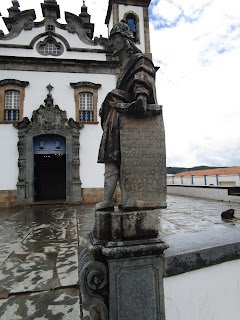 |
| The reason to visit Congonhas: Basílica do Senhor Bom Jesus de Congonhas. |
Scratch a big one off the ol' "before they cut my feet off" list: A trip to Congonhas, Brazil, to see the masterpiece by Brazilian sculptor Aleijadinho: The Prophets.
This was the primary reason for me visiting Belo Horizonte. Congonhas is an otherwise ordinary-looking small city about 90 minutes south of Belo Horizonte. There is only one attraction here: the Basílica do Senhor Bom Jesus de Congonhas.
But even the Basilica is not the attraction. It's nice, but it's not worth 12 hours of flying and two hours of driving to see. It's what is outside the Basilica that is the reason to visit Congonhas. Outside the Basilica is a collection of statues of the 12 Old Testament prophets carved in soapstone. Leading up the walk to the Basilica are six small building contained cedar wood carvings of scenes from the stations of cross. All were carved by the sculptor Aleijadinho, who lived from 1730 to 1814.
Let's start with the walk up the hill to the Basilica.
The first building depicts a scene from the Last Supper.
I did not have a wide angle lens to get in all the disciples in one shot, so there are two.
The next scene is in the Garden of Gethsemane, where the disciples are unable to stay awake with Jesus as Jesus prays about the events that are about to happen that evening.
Peter is one of the disciples in this picture. Some rock upon which to build a church!
Next is the arrest scene where Peter cuts off the ear of the Roman soldier and Christ performs the miracle of re-attaching the severed ear to the soldier's head.
The next shack depicts two scenes related to the trial at Pilate's house, I am guessing.
This is the only building containing two stations.
Aleijadinho did much of this carving with his body severely deformed. It is reputed that he has assistants fasten the carving tools to his arms because his hands became so deformed that he could not hold his tools. I'm guessing that if this were the case, it would have happened during the wood carving part of his work, rather than the stone carving.
This is the scene of Christ carrying his cross down the Via Dolorosa to Calvary. Note Veronica holding the veil.
Let's look upclose at the carving of Christ. Aleijadinho depicted Christ with a neck wound, which is not part of the Biblical story. This was done as a homage to Brazilian revolutionary martyr Tiradentes, who was hung.
Finally, we reach the scene where the nails are struck into the cross and the Romans cast lots for his cloak and garments.
Off to the side, waiting for their punishments, are the two thieves, including St. Dimas.
St. Dimas is the first saint identified in the Bible. When his cohort ridicules Jesus, he is rebuked by Dimas who reminds his co-criminal that they deserve their fate but that Jesus does not deserve his horrible punishment as he had done no wrong. He then asks Jesus to remember him when he comes into his kingdom, to which Jesus responds, "I tell you the truth, today you will be with me in paradise."
And the wood carvings are just the appetizer course. The main dish are the Prophets.
I do not know which of the 12 Prophets correspond with which particular statue. I'm not even going to try. So let's have a look at the bunch:
Here's a view from the Basilica looking out over Congonhas.
You will notice a fair number of relatively friendly stray dogs up top at the Basilica,
Dogs and statues.
This is a UNESCO World Heritage Site, by the way.
We've come this far. Let's look inside the chapel.
Rococo comes to Brazil!
Seriously. This church represents the transition from baroque to rococo in church architecture in Brazil.
Over-the-top ornate design in flowing patterns is the signature of the rococo style.
If you look up at the ceiling, holding up chandeliers, are two dragons.
These were a gift to the Basilica from the people of the Portuguese colony of Macau, China.
This is a close up of an interesting detail in the altar.
Veronica holding up her veil with the face of Christ imprinted on it.
The ceiling, with the Macau dragons visible.
And it is time to exit the Basilica.
And time to take a quick visit to the museum.
These are pictures of each of the prophets. Unfortunately, the videos for each of the 12 prophets moves so quickly, you cannot study which one is which, to match names to faces,
This is a mobile of the tools Aleijadinho would have used.
This is a picture that had been sent by someone to document a miracle that they believed happened in the curing of an illness.
And this is a depiction of the Basilica.
And we will conclude with what is believed to be a portrait of Aleijadinho himself.
This is the only known depiction of Aleijadinho from his time.
Again, Congonhas was on my list for quite some time. It now has been crossed off. It totally was worth the trip.

















































No comments:
Post a Comment